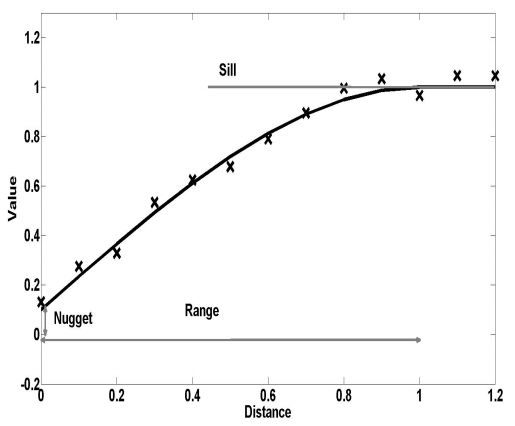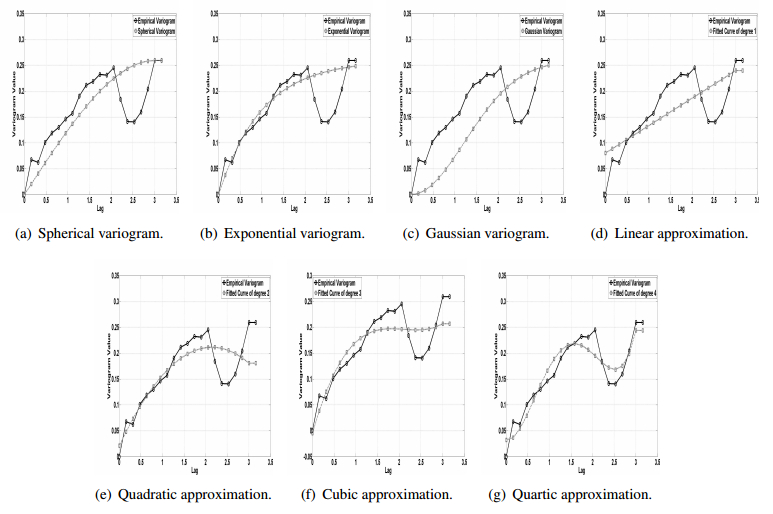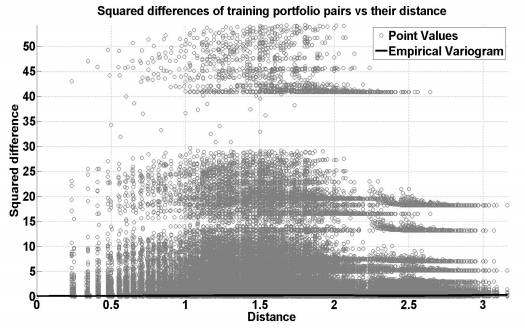Variable Annuity (VA) products expose insurance companies to considerable risk because of the guarantees they provide to buyers of these products. Managing and hedging these risks require insurers to find the values of key risk metrics for a large portfolio of VA products. In practice, many companies rely on nested Monte Carlo (MC) simulations to find key risk metrics. MC simulations are computationally demanding, forcing insurance companies to invest hundreds of thousands of dollars in computational infrastructure per year. Moreover, existing academic methodologies are focused on fair valuation of a single VA contract, exploiting ideas in option theory and regression. In most cases, the computational complexity of these methods surpasses the computational requirements of MC simulations. Therefore, academic methodologies cannot scale well to large portfolios of VA contracts. In this paper, we present a framework for valuing such portfolios based on spatial interpolation. We provide a comprehensive study of this framework and compare existing interpolation schemes. Our numerical results show superior performance, in terms of both computational effciency and accuracy, for these methods compared to nested MC simulations. We also present insights into the challenge of finding an effective interpolation scheme in this framework, and suggest guidelines that help us build a fully automated scheme that is effcient and accurate.
1.
Introduction
Consider D={z:|z|<1}, an open unit disc in the complex plane C, H as the collection of all analytic functions in D. Let A be the subclass of H consisting of all functions of the form
and S be a subclass of A containing all univalent functions. A function f∈A is starlike if f(D) is starlike with respect to origin and the class of all starlike functions f∈A is denoted by ST. Similarly, a function f∈A is convex if f(D) is convex with respect to all points of f(D) and the class of all convex functions f∈A is denoted by CV. An analytic function p:D→C of the form
satisfying ℜ(p(z))>0 for all z∈D is known as a function with positive real part. The class of such functions, denoted by P, is known as the class of Carathéodory functions. Note that ℜ(p(z))>0 can be written as |arg(p(z))|<π2. Connections between ST and P and CV and P are as follows: a function f∈ST if and only if zf′(z)f(z)∈P,z∈D and a function f∈CV if and only if 1+zf′′(z)f′(z)∈P,z∈D. Thus, the properties of ST and CV functions can be obtained from the properties of functions in the class P. Note that the Möbius function
is analytic and univalent in the open unit disc D and it maps D onto the right half-plane and is in the class P.
Even though many authors extensively explored the concept of starlikeness of a given order for a long time, Robertson [16] was the pioneer in introducing the concept of an analytic univalent functions mapping an open unit disc onto a starlike domain with respect to the boundary point. He constructed the subclass G∗ of H of functions g,g(0)=1 mapping D onto a starlike domain with respect to g(1)=limr→1−g(r)=0 and ℜ(eiρg(z))>0 for some real ρ and all z∈D. Assume also that the constant function 1 belongs to the class G∗. He conjectured that the class G∗ coincides with the class G,
such that
and proved that G⊂G∗. Later, this conjecture was confirmed by Lyzzaik [11] who proved G∗⊂G. Furthermore, if g∈G,g≠1 then g is univalent close-to-convex in D, as proved by Robertson [16]. It is worth mentioning that the analytic characterization (1.4) was known earlier to Styer [19].
In [3], a class G(M),M>1, consisting of all analytic and non-vanishing functions of the form (1.3), such that
which is a closely related function to the class G was introduced by Jakubowski [3]. Here,
is the Pick function. The class G(1) was also considered in [3], where
Todorov [20] linked the class G with a functional f(z)/(1−z) for z∈D and obtained a structural formula and coefficient estimates. Silverman and Silvia [17] introduced an interesting class G(β)⊂G∗,0<β≤1, consisting of all analytic function g of the form (1.3) and satisfying
Clearly, G(12)=G. For −1<A≤1 and −A<B≤1, Jakubowski and Włodarczyk [4] defined the class G(A,B), of all g of the form (1.3), satisfying ℜ(2zg′(z)g(z)+1+Az1−Bz)>0,z∈D (see also the work of Sivasubramanian [18]). Related works on the class G were considered earlier by [1, 6–10, 14]. We remark at this point, that the function
is univalent in D. In this article, we are interested in introducing and investigating a new class as follows.
Definition 1.1. Let Gc be the class consisting of all functions of the form (1.3) satisfying
where 0<c≤2.
If c=1, the class G1=G was introduced and investigated by Robertson [16]. For this new class of functions, we obtain representation theorem, interesting coefficient estimates and also certain differential subordination implications involving this new class.
Example 1.1. The function
is in the class Gc, where 0<c≤2.
Proof. Taking logarithm on both sides and by a simple differentiation, one can easily get
Hence,
implies g1∈Gc.
Example 1.2. The function
is in the class Gc, where 0<c≤2.
Proof. Taking logarithm on both sides and by a simple differentiation, one can easily get
Therefore,
implies that g2∈Gc.
Similarly, we can show that
Example 1.3. The function
is in the class Gc, where 0<c≤2.
Example 1.4. The function
is in the class Gc, where 0<c≤2.
The above examples show that there are many functions present in the class Gc proving that the class Gc is non empty.
2.
Representation theorems
Theorem 2.1. Let 0<c≤2. Furthermore, let
A function g is in Gc if and only if there exists a starlike function s∈ST such that
Proof. Suppose that s∈ST and g is given by (2.2). Then, g is analytic and g(0)=1. Therefore, from (1.5), we have for some function g satisfying (2.2), there exists a starlike function s such that
Hence,
By a simple differentiation followed by simplification we get,
where
Therefore,
Hence, g∈Gc.
On the other hand, suppose g∈Gc and
Then, s(0)=0,s′(0)=1 and
The above expression is positive as g∈Gc which implies s∈ST.
For the choices of c=1 and c=2 we get the following corollaries as listed below.
Corollary 2.1. [16] A function g is in G1 if and only if there exists a function s∈ST such that (g(z))2=(s(z)z)(1−z)2.
Corollary 2.2. A function g is in G2 if and only if there exists a function s∈ST such that g(z)=(s(z)z)12 exp(−21−z).
Theorem 2.2. (Herglotz representation theorem) Let 0<c≤2 and let g be an analytic function in D such that g(0)=1. Then, g∈Gc if and only if
where μ(t) is a probability measure on [−π,π].
Proof. Let 0<c≤2. If g∈Gc, we can write
By a simple integration and simplification we get,
Upon simplification of the above equation, one can obtain (2.3). The converse part can be proved by similar lines as in the necessary part and hence the details are omitted.
For c=1 and c=2 we get the following corollaries.
Corollary 2.3. [16] Let g be an analytic function in D such that g(0)=1. Then, g∈G1 if and only if
Corollary 2.4. Let g be an analytic function in D such that g(0)=1. Then, g∈G2 if and only if
Theorem 2.3. Let 0<c≤2. A function g∈Gc if and only if there exists a function p∈P such that
Proof. Let g∈Gc. Then, by the definition of Gc, for some function p∈P,
Upon integration and simplification, we get
which proves the necessary part of the theorem. Conversely, assume p∈P and p(0)=1 and let g be as in (2.4). Then, g is analytic in D and by applying simple calculations we can easily prove that g∈Gc.
For c=1 and c=2, we get the following corollaries.
Corollary 2.5. Let g∈G1 if and only if there exists a function p∈P such that
Corollary 2.6. Let g∈G2 if and only if there exists a function p∈P such that
Theorem 2.4. Let 0<c≤2. A function g∈Gc if and only if there exists a function p∈H such that p≺1+z1−z and for z∈D,
Proof. The proof follows from Theorem 2.3.
3.
Coefficient estimates for the class Gc
Theorem 3.1. Let 0<c≤2 and z∈D. If g∈Gc, we have the following sharp inequalities.
and
Further, for α∈R, let
Then,
Proof. Let
On expanding the right hand side of the above function p, we get
By making use of the known inequality |p_i| \leq 2 for all p \in \mathcal{P} , we can get the sharp inequalities given in (3.1)–(3.3). From (1.1) and (3.6) and from the known fact that
we can obtain (3.5)
For c = 1 and c = 2, we have the following corollaries as stated below.
Corollary 3.1. [2] Let z\in \mathbb{D} . If g \in \mathcal{G}_1 , we have the following inequalities.
Further,
All of these inequalities are sharp.
Corollary 3.2. Let z\in \mathbb{D} . If g \in \mathcal{G}_2 , the following inequalities hold.
Also,
All of these inequalities are sharp.
Theorem 3.2. Let 0 < c \leq 2 and let the function g(z) be of the form (1.3) belong to the class \mathcal{G}_c . Then, for n = 2, 3, \cdots , the following estimates
hold.
Proof. Let the function g of the form (1.3) belong to the class \mathcal{G}_c . Then, there exists a function p\in \mathcal{P} such that,
Since p\in \mathcal{P} , there exists a function \omega of the form
where \omega is analytic in \mathbb{D}, \omega\left(0\right) = 0, \left|\omega \left(z\right)\right|\leq 1 for z\in\mathbb{D} . Furthermore,
From (3.7) and (3.8), we have
Let
Considering the expansion of the function of g as power series, we get
(2+\sum_{n = 1}^{\infty}\left(d_n-cd_{n-1}+\frac{c(c-1)}{2!}d_{n-2}+\cdots+(-1)^{n-1} \, \frac{c(c-1)\cdots(c-n+2)}{(n-1)!}d_1+\\ (-1)^{n} \, \frac{c(c-1)\cdots(c-n+1)}{n!}\right)z^n\\+2\sum_{n = 1}^{\infty}\left(nd_n-c(n-1)d_{n-1}+\frac{c(c-1)}{2!}(n-2)d_{n-2}+\cdots+(-1)^{n-1} \, \frac{c(c-1)\cdots(c-n+2)}{(n-1)!}d_1\right)z^n\\+ \sum_{n = 1}^{\infty}\left(d_n+cd_{n-1}+\frac{c(c-1)}{2!}d_{n-2}+\cdots+\frac{c(c-1)\cdots(c-n+2)}{(n-1)!}d_1+\frac{c(c-1)\cdots(c-n+1)}{n!}\right)z^n)\left(\sum_{n = 1}^{\infty}\omega_n z^n\right)\\ = 2\sum_{n = 1}^{\infty}\left(nd_n-c(n-1)d_{n-1}+\frac{c(c-1)}{2!}(n-2)d_{n-2}+\cdots+(-1)^{n-1} \, \frac{c(c-1)\cdots(c-n+2)}{(n-1)!}d_1 \right)z^n\\+ \sum_{n = 1}^{\infty}\left(d_n+cd_{n-1}+\frac{c(c-1)}{2!}d_{n-2}+\cdots+\frac{c(c-1)\cdots(c-n+2)}{(n-1)!}d_1 +\frac{c(c-1)\cdots(c-n+1)}{n!}\right)z^n\\- \sum_{n = 1}^{\infty}\left(d_n-cd_{n-1}+\frac{c(c-1)}{2!}d_{n-2}+\cdots+(-1)^{n-1} \, \frac{c(c-1)\cdots(c-n+2)}{(n-1)!}d_1+(-1)^{n} \, \frac{c(c-1)\cdots(c-n+1)}{n!}\right)z^n .
For z \in \mathbb{D} , this can be again simplified to bring into the form,
For \ n = 2, 3, \cdots , let
and
From (3.9)–(3.11), we have
Equating the coefficient of z , we have
Since |\omega_1|\leq1 , we obtain
and for n = 2, 3, \cdots ,
From the Eqs (3.9)–(3.12), we have
where E_k are the appropriate coefficients. Since |\omega(z)| < 1 for z\in\mathbb{D} ,
By simplifying this, we have
Since |s_k(c)|^2\geq0 for k = 1, 2, \cdots, n-1, we obtain
This essentially completes the proof of Theorem 3.2.
Let us consider the class \mathcal{B} defined by \mathcal{B} = \left\{\omega \in\mathcal{H}: \left|\omega (z)\right|\leq 1, z\in \mathbb{D}\right\} and \mathcal{B}_0 be the subclass of \mathcal{B} consisting of functions \omega such that \omega(0) = 0. The elements of \mathcal{B}_0 are also known as Schwarz functions.
Lemma 3.1. [5] If \omega \in \mathcal{B}_0 is of the form \omega(z) = \sum\limits_{n = 1}^{\infty}\omega_n z^n, \ z\in\mathbb{D}, then for \nu\in\mathbb{C} ,
Lemma 3.2. If \omega\in\mathcal{B}_{0} is of the form \omega(z) = \sum\limits_{n = 1}^{\infty}\omega_n z^n, \ z\in\mathbb{D}, then for any real numbers q_1 and q_2 , the following sharp estimates holds:
where
and the sets D_k, k = 1, 2, \cdots are defined in [15].
Now we obtain a few upper bounds for early coefficients and for the Fekete-Szegö functional in the class \mathcal{G}_c .
Theorem 3.3. Let g\in\mathcal{G}_c, 0 < c\leq2 . Then,
and
Furthermore, for \delta\in\mathbb{R}
Proof. From the class \mathcal{G}_c , there exists \omega\in\mathcal{B}_0 of the form \omega(z) = \sum\limits_{n = 1}^\infty\omega_n z^n, \ z\in\mathbb{D} , such that
Since
and
By comparing the corresponding coefficients from (3.21)–(3.23), we have the following:
and
Since |\omega_1|\leq1 , from (3.24),
and hence
From (3.25) and by Lemma 3.1, we have
and
which in turn gives
and hence
From (3.26) and by Lemma 3.2, we get
Hence, we obtain
Substituting the formulas for d_1 and d_2 , we obtain
Therefore,
Furthermore, we get
The proof of the theorem is completed by virtue of Lemma 3.1.
It can be remarked here that if \nu is a real number, Lemma 3.1 can be improved in the following way and can be found in [2].
Lemma 3.3. If \omega \in \mathcal{B}_0 is of the form \omega(z) = \sum\limits_{n = 1}^{\infty}\omega_n z^n, \ z\in\mathbb{D}, then
For \nu < -1 or \nu > 1 , equality holds if and only if \omega\left(z\right) = z or one of its rotations. For -1 < \nu < 1 , equality holds if and only if \omega(z) = z^2, \ z\in\mathbb{D} or one of its rotations. For \nu = -1 equality holds if and only if \omega(z) = \frac{z(\lambda+z)}{(1+\lambda z)}, z\in\mathbb{D} or one of its rotations, while for \nu = 1 equality holds if and only if w(z) = \frac{-z(\lambda+z)}{(1+\lambda z, )}, 0\leq\lambda\leq1, z\in\mathbb{D} or one of its rotations.
We can improve the results obtained in (3.20), in view of Lemma 3.3 as follows: For \delta\in\mathbb{R} , we get,
Theorem 3.4. Let 0 < r < 1 . If g\in\mathcal{G}_c then for |z| = r < 1 ,
Proof. Let us define
Note that the function g is non-vanishing in \mathbb{D} . Therefore, f is analytic in \mathbb{D} and a simple computation shows that
From (3.31), we can see that g\in \mathcal{G}_c if and only if f\prec\frac{1+z}{1-z}, z\in\mathbb{D} . By applying the result of Ma and Minda [12], we infer that
Hence,
which gives (3.29).
For c = 1 and c = 2 we have the following corollaries.
Corollary 3.3. For 0 < r < 1 , if g\in\mathcal{G}_1 then we have for |z| = r < 1
Corollary 3.4. For 0 < r < 1 , if g\in\mathcal{G}_2 then we have for |z| = r < 1 ,
Theorem 3.5. Let g\in \mathcal{G}_c . Then,
and
Proof. Since g\in \mathcal{G}_c , there is a Schwarz function \omega satisfying that
If \omega(z) = z , we have
Equating the coefficients using (3.22),
Since 0 < c\leq2 , (3.36) holds.
Also, since 0 < c\leq2 ,
implies that (3.37) holds.
4.
Differential subordination involving the class \mathcal{G}_c
In this section we are connecting the class \mathcal{G}_c , 0 < c\leq2 by taking the equivalent condition of \mathcal{G}_c , 0 < c\leq2 associated with L_0(z) = \frac{1+z}{1-z} . Note that the definition \mathcal{G}_c, 0 < c\leq2 can be rewritten in the equivalent form as g \in \mathcal{G}_c if
To prove the differential subordination results, we need the following lemma which is stated below.
Lemma 4.1. [13] Let \tau be univalent in \mathbb{D} , \psi and \phi be analytic in a domain D containing \tau(\mathbb{D}) with \phi(\omega)\neq0 when \omega\in \tau(\mathbb{D}) . Let T(z) = z \tau' \phi(\tau(z)) and \kappa(z) = \psi(\tau(z))+T(z) for z\in \mathbb{D} and satisfy either T is starlike univalent in \mathbb{D} or \kappa is convex univalent in \mathbb{D} . Also, assume that \Re \left\{\frac{z\kappa'(z)}{T(z)}\right\} > 0, z\in \mathbb{D}. \\ If p\in \mathcal{H} with p(0) = \tau(0), p(\mathbb{D})\subset D , and
then p\prec\tau and \tau is the best dominant.
Theorem 4.1. Let g be an analytic function with g(0) = 1 and let 0 < c\leq2 . If g satisfies
then
Proof. Let \psi(\omega) = 1, \omega\in\mathbb{C} and \phi(\omega): = \frac{1}{\omega}, \omega\in \mathbb{C}\setminus \left\{0\right\} . Note that L_0(\mathbb{D}): = \mathbb{C}\setminus\left\{0\right\} . Thus,
is analytic and also well defined. Also, we have
This implies that T is a starlike univalent function. From this, for a function \kappa(z): = \psi(L_0(z))+T(z) = 1+T(z), z\in \mathbb{D} , we get
From Lemma 4.1,
which implies that p\prec L_0 . Let us take the analytic function g with g(0) = 1 and g(z)\neq0 for z\in\mathbb{D} satisfying (4.2). For a function as in (4.3), we can notice that p(0) = L_0(0) = 1, p(z)\neq0 for z\in\mathbb{D} and p is analytic. The proof of Theorem 4.1 is completed by observing that
Theorem 4.2. Let g(z) be an analytic function with g(0) = 1 and let 0 < c\leq2 . If
then
Proof. Let \psi(\omega) = \omega, \omega\in\mathbb{C} and \phi(\omega): = \frac{1}{\omega}, \omega\in \mathbb{C}\setminus \left\{0\right\} . Note that L_0(\mathbb{D}): = \mathbb{C}\setminus \left\{0\right\} and \psi and \phi are analytic in D . Thus, T defined by (4.4) is analytic and univalent and satisfies (4.5). Hence, \kappa(z) = \psi(L_0(z))+T(z) = L_0(z)+T(z), \ z\in \mathbb{D} . By using (4.5) we get,
Note that, p is also analytic with p(0) = L_0(0) = 1 and p(z)\neq0 for z\in\mathbb{D} . From Lemma 4.1, we have
This essentially gives us that p\prec L_0 . Let us take the analytic function g with g(0) = 1 and g(z)\neq0 for z\in\mathbb{D} satisfying (4.6). For a function defined as in (4.7), we can observe that
Therefore, p(z)\neq0 and analytic for all z\in \mathbb{D} . The proof of the theorem is then completed by noting that
Use of AI tools declaration
The authors declare they have not used Artificial Intelligence (AI) tools in the creation of this article.
Acknowledgments
The authors are thankful to the referee(s) for many insightful suggestions and comments in the original manuscript. The second author was supported by the Basic Science Research Program through the National Research Foundation of Korea (NRF) funded by the Ministry of Education, Science and Technology (No. 2019R1I1A3A01050861).
Conflict of interest
The authors declare that they have no competing interests.
















 DownLoad:
DownLoad: